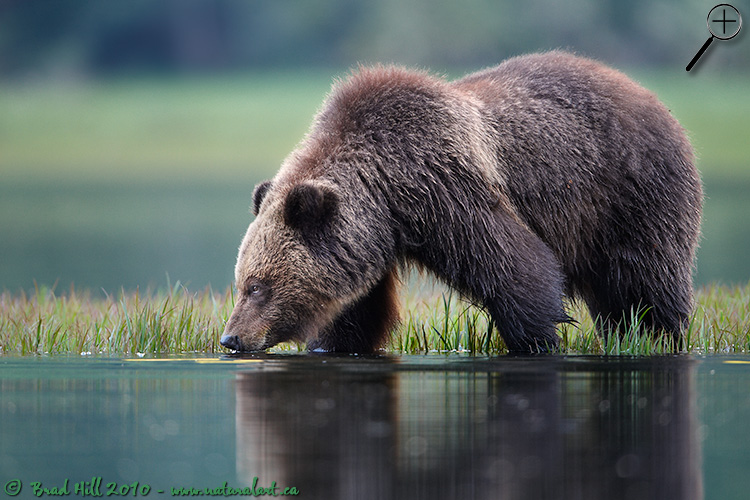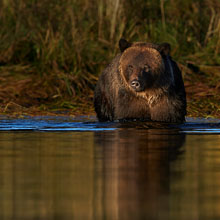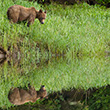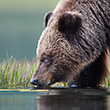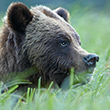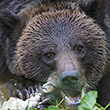In the Field
The Night Cap. Khutzeymateen Inlet (Great Bear Rainforest), BC. June 2, 2009.
And now...time for something a little softer and more subtle. I captured this adult grizzly grabbing an evening drink a couple of hours after the sun went behind the high, steep rock walls of the Khutzeymateen Inlet. I was attracted to the scene by the soft colours and soft light, and when the bear slowly dropped its head to take a drink I couldn't resist capturing this image.
Nikon users who have spent time photographing bears in the Great Bear Rainforest almost universally acknowledge that Nikon's 200-400 mm f4 VR lens is the single best lens you can take (and use) there. I'm of the same opinion - the 200-400 just rocks in the GBR! However, this year my 200-400 malfunctioned (dead focusing system) half-way through my time in the Khutzeymateen and I was forced to put the lens away and shoot with alternate lenses. I had two telephoto primes with me - my 200 mm f2 VR and my 600 mm f4 VR and had no choice to do all my shooting with these lenses. I suppose if I didn't already have thousands of bear images in my collection I would have been choked - but I simply looked at my sudden lens constraints as a challenge.
In the case of this image, I was forced to go either in tight on the bear (with the 600) or back off and use the 200 to produce more of an animalscape shot. I knew that if I selected the 600 I would produce a tightly framed image with the bear's reflection cut off (which, in a perfect world, I would have liked to keep) BUT in using the 600 I could effectively throw the background out-of-focus and go with a very "soft" theme. I had little time to make my decision, so I opted to go with the 600 and go soft (and sacrifice that reflection, but it was blurred anyway...). My biggest challenge was then getting a sharply focused shot...I was in a zodiac and was forced to hand-hold the huge 600 at a relatively long shutter speed. Fortunately, between good luck and the lens's effective VR system, I managed to capture an image with a very sharp subject and a pleasingly blurred background.
While I'm not sure I'd recommend putting your most versatile lens away in the middle of a critical wildlife shoot, I have to admit that when my 200-400 failed I was really forced to look at my subject matter differently and I think I benefitted from the experience. The shots I subsequently captured may not have been what I had been planning on, but I did come away with some images I like and definitely images different than the guys I was shooting with...
This image was captured during my annual "Grizzlies of the Khutzeymateen" Instructional Photo Tour in the spring of 2009. If you're interested in joining me on one of my photo tours into the Great Bear Rainforest, check out the details on my "Photo Tours" page. My Instructional Photo Tours into the Great Bear Rainforest are run in conjunction with Ocean Light II Adventures - they offer a number of amazing adventure tours (including top-notch bear-viewing tours as well as tours of exploration of the Queen Charlotte Islands) and I highly recommend them!
PS: When I returned from the northern coast I had a pleasant surprise - my 200-400 had 10 days remaining on it's 5-year warranty! Someone (Photeus?) was smiling on me!
Behind the Camera
The Night Cap. Khutzeymateen Inlet (Great Bear Rainforest), BC. June 2, 2009.
Digital Capture; Compressed RAW (NEF) 14-bit format; ISO 1600.
Nikon D3 with AF-S Nikkor 600mm f/4G IF-ED II VR lens - handheld. VR turned to "On" and in "Normal" mode.
1/160s @ f4; no compensation from matrix-metered exposure setting of camera.
At the Computer
The Night Cap. Khutzeymateen Inlet (Great Bear Rainforest), BC. June 2, 2009.
RAW Conversion to 16-bit TIFF, including first-pass/capture sharpening and automatic noise reduction, using Phase One's Capture One Pro 4.8. Three RAW conversions at different exposure settings - ranging from -1.0 stops (for background and foreground) through to +0.75 stops (to assist in recovery of shadow detail and balance lighting on various parts of the bear).
Further digital corrections on 16-bit TIFF file using Adobe's Photoshop CS4. Adjustments included compositing and masking of 3 exposure versions, selective colour saturation and desaturation, selective application of warming filter (to the bear only) and selective sharpening for web output.
Conservation
The Night Cap. Khutzeymateen Inlet (Great Bear Rainforest), BC. June 2, 2009.
Ten percent of the revenue generated by this image will be donated to Raincoast.
Species Status in Canada*: Special Concern (May 2002).
While Grizzly Bears (Ursus arctos) are not technically listed as "Endangered" in Canada, they have been extirpated from most of their historical range. Grizzly Bears are far more sensitive to intrusion/disturbance in their habitat than are Black Bears and are being increasingly forced into marginal habitat by human encroachment. The Great Bear Rainforest along the central and northern coast of British Columbia is one of the last strongholds of the Grizzly Bear in Canada, and even this population is coming under increasing pressure.
On December 18, 2017 the government of British Columbia banned grizzly hunting across the entire province. This major conservation victory came after decades of tireless work by many dedicated conservationists and ecologists and, most importantly, it reflects the opinion of the vast majority of British Columbians. And, it means that AT LEAST while the current government remains in power grizzlies are finally "safe" in British Columbia.
Now that we've at least temporarily won the battle to save grizzlies in BC, it's time to re-focus our efforts toward protecting ALL of BC's carnivores, including Gray Wolves, Black Bears, Cougars, Wolverines, and more! Simply put, there are no ecological, economic, or ethical arguments supporting the trophy hunting of carnivores.
In a great first step towards ending the hunting of carnivores throughout BC the Raincoast Conservation Foundation has developed a program designed to protect ALL carnivores within the Great Bear Rainforest. Details about this program can be found on this page on Raincoast's website. Check it out and, better yet, make a donation to help Raincoast purchase the remaining commercial hunting tenures in the Great Bear!
*The Raincoast Conservation Society (and Foundation) is an effective and efficient organization that has been fighting for protection of this unique habitat. If you are looking for a meaningful way to contribute to the conservation of this amazing ecosystem, Raincoast will provide maximal "bang" for your conservation dollars.
For more information on the status of Grizzly Bears in Canada, go to: http://www.speciesatrisk.gc.ca and search under "Grizzly Bears".
*as determined by COSEWIC: The Committee on the Status of Endangered Wildlife in Canada












